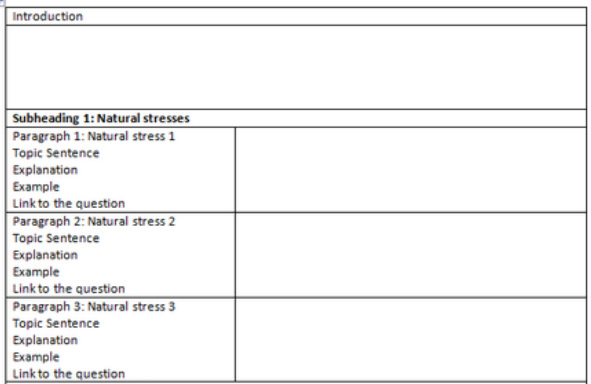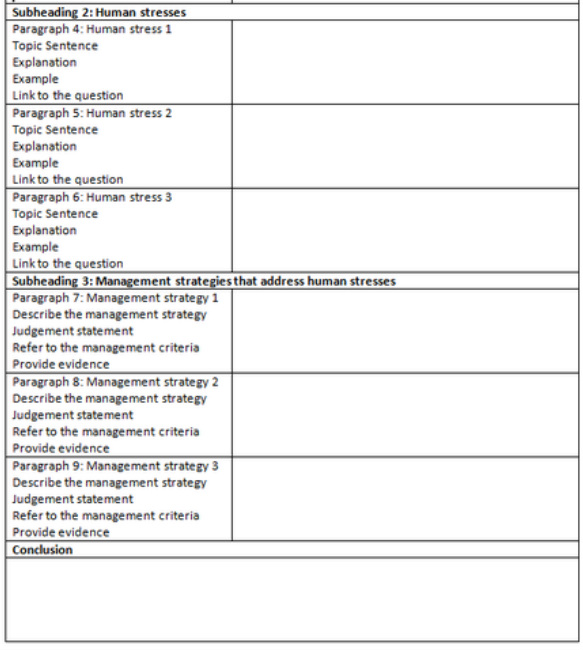Assessment 1 Scaffold
How do I go about addressing this question?
Describe the natural and human-induced stresses placed on intertidal wetlands or coral reefs. Analyse the effectiveness of management strategies which have been implemented to address the human impacts on the ecosystem.
Consider it as a multi-part question:
Describe the natural and human-induced stresses placed on intertidal wetlands or coral reefs. Analyse the effectiveness of management strategies which have been implemented to address the human impacts on the ecosystem.
Your response should be divided up into the same structure.
Introduction:
Give an overview of all the key parts of the response. Include statements which relate to the three aspects of the question. List stresses and management strategies. Do not go into too much detail.
Part 1: Describe natural stresses placed in intertidal wetlands.
Provide an overview of all the natural stresses that affect intertidal wetlands. Go into some detail about the stresses and how they impact on the ecosystem. This section should only be a couple of paragraphs.
Part 2: Describe human-induced stresses placed on intertidal wetlands.
Provide an overview of all the human stresses that affect intertidal wetlands. Go into some detail about the stresses and how they impact on the ecosystem. This section should only be a couple of paragraphs.
Part 3: Analyse the effectiveness of management strategies related to human stresses/impacts.
In this section you will need to describe the management strategy (be sure to choose one that relates to human stresses), make a judgement as to whether the strategies is effective or not (does it work?), refer to the effectiveness criteria, and then provide evidence. You should follow this process for every management strategy you look at. This section should be 4-5 paragraphs long (possibly longer depending on how you are going for time).
Conclusion:
Sum up your response here. This will restate what the natural and human stresses are. You will also list the management strategies again, but this time you might like to make a brief comment about which ones are effective or ineffective. In your conclusion, I wouldn’t worry too much about the criteria you used to judge their effectiveness.
Other tips:
Subheadings are a good way to make it clear to the reader that you are addressing a new part of the question.
Scaffold:
Describe the natural and human-induced stresses placed on intertidal wetlands or coral reefs. Analyse the effectiveness of management strategies which have been implemented to address the human impacts on the ecosystem.
Consider it as a multi-part question:
Describe the natural and human-induced stresses placed on intertidal wetlands or coral reefs. Analyse the effectiveness of management strategies which have been implemented to address the human impacts on the ecosystem.
Your response should be divided up into the same structure.
Introduction:
Give an overview of all the key parts of the response. Include statements which relate to the three aspects of the question. List stresses and management strategies. Do not go into too much detail.
Part 1: Describe natural stresses placed in intertidal wetlands.
Provide an overview of all the natural stresses that affect intertidal wetlands. Go into some detail about the stresses and how they impact on the ecosystem. This section should only be a couple of paragraphs.
Part 2: Describe human-induced stresses placed on intertidal wetlands.
Provide an overview of all the human stresses that affect intertidal wetlands. Go into some detail about the stresses and how they impact on the ecosystem. This section should only be a couple of paragraphs.
Part 3: Analyse the effectiveness of management strategies related to human stresses/impacts.
In this section you will need to describe the management strategy (be sure to choose one that relates to human stresses), make a judgement as to whether the strategies is effective or not (does it work?), refer to the effectiveness criteria, and then provide evidence. You should follow this process for every management strategy you look at. This section should be 4-5 paragraphs long (possibly longer depending on how you are going for time).
Conclusion:
Sum up your response here. This will restate what the natural and human stresses are. You will also list the management strategies again, but this time you might like to make a brief comment about which ones are effective or ineffective. In your conclusion, I wouldn’t worry too much about the criteria you used to judge their effectiveness.
Other tips:
Subheadings are a good way to make it clear to the reader that you are addressing a new part of the question.
Scaffold:
| assessment_1_-_hints_and_tips.docx |


